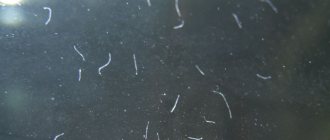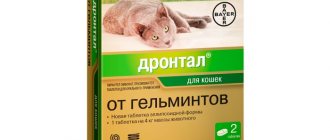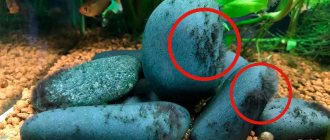Worms in dogs can threaten human health. It is usually not possible to determine that a dog is infected with cestodes by external signs. In case of severe infection, segments of parasites of various lengths are noticeable in the animal’s feces. The coat of an infected animal is tousled and dull, the dog is constantly thirsty and indifferent to food. Each of the following types of worms causes a specific helminthic disease in a dog, with characteristic symptoms and the ability to become chronic, leading to depletion of the dog. It must be borne in mind that nematodes and whipworms can easily infect humans.
The following types of worms parasitize dogs:
Nematodes (roundworms)
Nematodes are the most extensive group of helminth infections. Various types of nematodes parasitize almost all organs and tissues of the animal.
A large number of nematodes can cause the formation of a lump of worms in the puppy’s intestines, causing blockage and death of the pet. Pneumonia is also possible as a result of the migration of larvae through the lungs.
The diagnosis is made based on the detection of parasite eggs in the stool. Whole parasites or their segments are sometimes passed in the feces.
Prevention of infection with worms is mandatory for female dogs before mating, since the larvae of some roundworms can be transmitted to puppies in the womb. It can be especially difficult to cure children from nematodes (toxocar and toxascarid). A dog infected with worms will produce less strong and active puppies than a healthy one.
Ways of infecting a dog with worms
Basically, helminths enter the animal’s body in several ways. Infection of the puppy from the mother occurs when the fetus passes through the birth canal. This is only possible if the mother herself suffers from helminthic infestation.
Contact with sick animals is considered the main source of transmission of worms. Therefore, it is not advisable to walk your pet without a collar and allow it to approach yard dogs.
Infection occurs through external sources: water; the soil; dog feces; rivers; puddles. If a pet comes into close contact with these sources, parasite damage may develop.
Some forms of worms are also carried by blood-sucking animals - fleas and ticks. For prevention, you should use special protective equipment, wash your dog regularly, and visit a veterinarian.
What is the danger of worms in dogs?
There are different dangers. In some cases, these pests may not cause any discomfort or harm. On the other hand, they will lead to death.
There are different types of worms in dogs, and each one causes serious damage or does not cause harm at all. To find out if your dog has worms, get tested. This is exactly how helminthiasis is determined. Regular examination and taking special medications makes it possible to avoid the disease.
But in some cases it is not possible to regularly show the animal to a specialist. But you can give special preparations against pests, check with a specialist or at a pet store. Veterinarians recommend Drontal plus . This is an excellent disease prevention. Give according to prescription.
Many worms are dangerous because they cause mechanical damage to internal organs. They attach to the intestines, heart, liver. They suck out nutrients. Internal organs are pierced. As a result, wounds appear that fester and serious inflammation results.
In addition, worms in dogs are dangerous due to the toxins they secrete. They feed, and then in the usual way all the food leaves the worm’s body, thereby creating chemicals in the dog’s tissues that lead to toxicity. Vomiting begins.
The danger also lies in their numbers. If a large number of worms are formed, they thereby clog the patency of the intestines and esophagus. They can simply come out and block the airways. In all cases, death is possible if help is not provided at a certain moment.
Signs of worms in dogs
In some cases, if a dog has a helminthic infestation, no symptoms occur for a long time. Therefore, in order to promptly identify parasitic worms in your dog, you need to regularly take your dog for a preventive examination to a veterinary clinic.
Worms in a dog. Typical signs of worms in dogs are:
- disturbances in the functioning of the gastrointestinal tract: the dog develops a changeable appetite (periodic lack of appetite, or increased appetite), against the background of a decrease in body weight;
- the dog has perverted taste preferences for food; begins to eat inedible objects. Periodic digestive disorders and intestinal motility occur, which is manifested by frequent cramps, vomiting, diarrhea or constipation;
- upon careful examination of the stool, we find mucus, blood, eggs, larvae or parasites in it. We register severe itching in the anal area. The dog strives to get rid of the itching through characteristic movements (“rides” on the back of the body);
- upon external examination, the owners note a swollen and hard abdomen in the dog against the background of protruding ribs. After eating, we notice hiccups in the dog; eating is difficult;
- Upon examination, the dog is lethargic, inactive, with symptoms of general anemia . The coat is dull and disheveled, the dog has a tendency to develop dermatitis, eczema, and dandruff;
- The dog is characterized by retarded growth and development, and the appearance of rickets.
If your dog exhibits at least one of the above signs, you and your pet need to visit a veterinary clinic. Sometimes a dog may look completely healthy on the outside, but this does not mean that your dog does not have worms.
Symptoms
For a long time, the presence of helminths in the body can pass without any external symptoms; it is easy to confuse the signs of worms in the body with another disease, which is very similar in its symptoms. To eliminate the possibility of parasites in the dog’s body, it is necessary to examine the dog very carefully, take tests, based on them, the veterinarian will be able to reliably say whether the dog has worms or not. You can detect suspicion of parasites on your own; the animal will change its behavior, its activity will worsen, the pet will lie down more than walk, it may have difficulty breathing, and the mucous membranes may become covered with a white coating. The coat becomes much tougher, and dandruff and other skin problems may occur.
Obvious signs of helminths include loss of appetite (or, conversely, too much appetite), weight loss, nausea, diarrhea, and vomiting. You should be wary if the dog begins to actively eat something that it had never even touched before; perhaps it will even be something inedible. If this list of symptoms is added to the presence of strange grains and mucus in the animal’s feces, as well as itching in the anus and bloating, you immediately need to show your pet to a veterinarian.
Symptoms of a dog being infected with worms
How to find out if a dog has worms on your own? This question interests many who have a pet and care about its health. Because some forms of parasites spread quickly, affecting vital organs.
If dogs have lungworms, they may experience signs such as: shortness of breath; frequent cough; sneezing; deterioration of health; respiratory dysfunction.
Worms in dogs are characterized by symptoms. They, according to the degree of damage, types of parasites, their localization, can be pronounced or weak.
Even with the naked eye you can see traces of blood, adult parasites or worms, and characteristic mucus in your pet’s stool. Tapeworms in dogs are much more likely to cause constipation because they are large in size and can block the intestinal lumen.
Often, the signs of helminths in dogs have a complex manifestation:
- exhaustion of the body, lack of mood, impaired activity;
- the appearance of malfunctions in the gastrointestinal tract;
- weight loss, poor development, slow growth; lack of appetite;
- the external condition of the coat noticeably deteriorates, becomes dull, and may fall out;
- pallor of the mucous membranes; frequent constipation, diarrhea, vomiting
Parasitic roundworms (nematodes)
As we wrote above, this is one of the most common types of animal helminths throughout the world. Roundworms are of particular interest because they relatively recently (by biological standards) switched to a parasitic lifestyle.
This determines many features of their structure:
- The larvae of parasitic nematodes initially need free oxygen for development. To obtain sufficient quantities of it, the larvae (larval stage) migrate directly to the pulmonary emphysema.
- Unlike the same cestodes (and they are real “veterans” of the parasitic lifestyle), nematodes have a full-fledged digestive (including the oral cavity and fairly sharp teeth) and nervous systems, and they have very well developed muscles. The latter is especially important for these worms, since they remain in the lumen of the intestines solely due to constant movement in the thickness of semi-digested food masses.
- Most roundworms are dioecious, which is rare for the other two groups of helminths. Because of this, in particular, many cases of heartworm infections simply cannot be detected due to the absence of larvae in the blood. But they don’t exist because a dog’s body can contain only male or only female worms.
Life cycle of worms
As a rule, it is not enough for all parasitic helminths to simply enter the dog’s body along with food in the form of eggs or ready-made larvae: before this, young worms must necessarily mature in the body of one or more additional hosts.
After this, the development cycle in most cases looks like this:
- The larvae emerge from the eggs or the body of the intermediate host, after which, gnawing into the wall of the intestines, they reach the nearest blood vessel.
- Having broken through the wall of the latter, the parasites migrate into the lung tissue along with the general blood flow.
- They remain in the pulmonary alveoli and bronchi for about two or three weeks, during which the larvae eat the tissue with appetite, simultaneously also feeding on the animal’s blood. Young and old dogs, whose immune systems are not particularly strong, often develop acute bronchitis and even pneumonia because of this.
- When this period expires, the bodies of the parasites begin to secrete irritating compounds that cause a local inflammatory reaction, which provokes a cough. Together with abundantly released sputum, the parasites enter the gastrointestinal tract a second time, where this time they remain “at their permanent place of residence”, no longer migrating anywhere.
Routes of infection
It is interesting that ascariasis can be transmitted in several ways at once:
- Alimentary infection. The most common case is when parasites enter the dog’s body along with food contaminated with worm eggs.
- Infection through intermediate hosts. The latter are often played by mouse-like rodents, sometimes insects, birds, and amphibians. Of course, dogs are much less likely than cats to catch and eat small animals, but this route of infection cannot be called rare either.
- Infection with mother's milk. Above we described the process of primary migration of larvae from the intestine to lung tissue. The problem is that not all parasites travel to the lungs. Part settles in the tissues of the mammary glands.
- Intrauterine infection. Migrating larvae easily overcome the placental barrier, after which they are introduced into the body of the puppies. And the birth of already infected babies is far from the worst thing. Parasites may well damage the vital organs of unborn puppies.
Some types of roundworms are also characterized by a more bizarre type of infection, when the parasite larvae enter the dog's body through the skin on the paw pads.
However, in such cases, most often everything is limited to the development of dermatitis, but often young parasites reach the internal organs.
Symptoms of ascariasis
A dangerous feature of roundworms is their feeding habits: many species are not content with eating semi-digested food masses, but prefer to dilute their diet with mucous membranes and blood. Accordingly, permanent damage to the intestinal lining does not go away without a trace: inflammatory processes develop, accompanied by serious digestive disorders.
In adult and physically strong animals, the clinical picture may either be absent altogether, or it may be extremely vague and not obvious. But this applies only to those cases where there are relatively few parasites. In other situations, the compensatory reserves of the mechanism will sooner or later be exhausted.
What are the symptoms:
- Characterized by the development of exhaustion, as well as a sharp and clearly visible deterioration in the quality of the skin and coat.
- If there are a lot of parasites, and they belong to “blood-sucking” species, anemia is almost inevitable.
- Constipation is quite typical, interspersed from time to time with bouts of diarrhea.
- In the case of a critically severe helminthic infestation, when the intestines are literally clogged with the bodies of parasitic worms, the risk of perforation (i.e. rupture) of the intestine becomes quite real. The walls of the organ, eaten away by the “guests,” simply cannot withstand the constant increase in internal pressure.
- The migration of roundworm larvae from the lungs to the intestines is accompanied by the development of strong and persistent coughing attacks.
- All the same larvae, but migrating from the intestines to the lungs, carry a lot of pathogenic and conditionally pathogenic microflora on themselves and in their internal organs. Once in the lungs, these microbes feel great and contribute to the development of severe inflammation.
In dogs, some types of parasitic nematodes can reach a length of 20 cm (but this does not happen often). Cases of very severe helminthic infestation are fraught with the appearance of balls of worms in the feces or vomit.
It is especially bad when the worms are thrown out along with vomiting: this directly indicates a very strong intensity of the infestation. The fact is that under “normal” conditions, roundworms move extremely actively in the intestines, and therefore do not come out. And only in cases where there are a critically large number of parasites, they can no longer maneuver in the intestinal lumen.
What types of ascariasis are there?
Typically, particularly exotic cases are not encountered in veterinary practice. Much more often, specialists are faced with two or three types of ascariasis.
Toxocariasis
One of the most common helminths worldwide. In dogs, two types are more common:
• Toxascaris leonina. • T. canis.
These are quite large parasites, the females of which can grow to a length of more than ten centimeters. It is believed that these worms use small mouse-like rodents as an intermediate host. But there is evidence that infection with Toxascaris leonina can also occur after a dog eats food contaminated with helminth eggs.
With a severe degree of parasite infestation, there may be so many parasites in the dog’s intestines that the pet has a real risk of dying from intestinal rupture.
Heartworms
The disease they cause is called dirofilariasis. The intermediate host is a mosquito or mosquito. They carry parasite larvae (dirofilaria) into the general bloodstream. Together with the blood flow, small parasites enter the chambers of the heart and pulmonary arteries, where they remain for the rest of their lives. Several of these helminths can live in a dog’s body at once.
In dogs the disease is severe:
- Shortness of breath develops, breathing is hoarse and heavy.
- In severe cases, edema occurs, and the dog may well die from pulmonary edema, accompanied by copious foamy discharge from the pet’s mouth.
Worms can live in the cavities of a dog’s heart for up to six years, and the animal’s problems do not end with the death of the worms. Pieces of parasites' bodies can easily and naturally clog the lumen of even large vessels, resulting in either sudden death or gangrene.
In addition, even with treatment, heartworms can cause many problems. Currently, many veterinarians prefer to use a rather complex surgical operation to remove them from the animal’s body. This is done because conventional antiparasitic drugs are not suitable for destroying adult forms of these helminths, since they do not give any effect (however, the same ivermectin effectively destroys heartworm larvae).
It is necessary to use organic arsenic compounds to “kill” parasites, which do not have the best effect on the dog’s body. At the slightest deviation from the dosage, the animal can easily die or become disabled with progressive liver/renal failure. Therefore, dirofilariasis is treated exclusively in a clinic, but not at home.
Toxocara worms in dogs
Toxocara canis : a whitish worm up to 15 cm long, strongly pointed at the ends. Live parasites found in feces are coiled into a tight spring or flat spiral. If the parasites are small, owners often think that the dog has swallowed threads. Toxocara females are incredibly fertile - about 200,000 eggs per day!
Dogs become infected in utero, through mother's milk or through contact with a contaminated surface. Toxocara eggs remain active for up to a year, not afraid of the sun and cold! After ingestion, the eggs quickly turn into larvae that literally gnaw through the intestinal wall. From there they go to the liver and then to the lungs.
These roundworms cause severe respiratory symptoms in dogs - cough, shortness of breath, etc. From the lungs, some of the larvae enter the bloodstream into organ tissue and are inactivated.
Others are coughed up, swallowed and end up in the intestines, where they develop into adults. Reproduction occurs in the intestinal tract - eggs are constantly released into the external environment. A similar species, toxascaris leonna, also lives in the intestines, but the larvae develop in the stomach without migrating. And therefore they cause much less harm.
General information
In general, worms of this type are extremely “versatile”. They are found in the bodies of almost all mammals, including whales, as well as reptiles, fish, birds and amphibians. Fortunately, most of them are very specific; worms can only parasitize the body of certain types of warm-blooded animals. There are, of course, “universalists”, but they are few.
More than 90% of adult roundworms live in the lumen of the small intestine , but there are also species localized in the lungs, heart, blood vessels and even the stomach. All parasitic nematodes are extremely prolific, and one sick pet can release millions of invasive eggs into the environment in a day. However, these are only general characteristics of worms: many of them have extremely specific and quite complex life cycles. Therefore, the dog’s owner needs to know not only the signs of infection, but also the routes of infection, since otherwise you are unlikely to be able to prescribe complete and effective therapy, and preventing infection will be even more difficult.
In this article it is impossible to cover even a tenth of all varieties of parasitic roundworms, and therefore we will consider Toxocara. Their life cycle is similar to that of other parasites, and the prevalence is so high that some veterinarians say at least 67% of all dogs in our country are affected (the situation in the world is approximately the same).
Hookworm worms in dogs
Ancylostoma caninum: small yellowish nematode up to 2 cm long, the head end of the worm is rounded. The oral apparatus is huge in comparison with its overall size, consisting of several rows of sharp, hook-shaped teeth. The worm bites into the intestinal wall, swallows fragments of the mucous membrane and drinks blood, causing anemia, spasms, and inflammatory processes.
Distributed everywhere. Infection through the skin is possible - the larvae migrate to the bronchi and lungs, molt several times, cough up and enter the intestines. While the dog has worms in his lungs, obvious breathing problems appear (shortness of breath, wheezing, coughing, etc.). Without treatment, death is possible, especially if we are talking about a puppy or young dog.
Symptoms and diagnostic techniques
As a rule, round parasitic worms feed not only on semi-digested food masses (chyme), but also on mucous membranes and blood. All this often leads to the development of severe digestive disorders. Again, with moderate infestation, symptoms may not appear. In other cases, pets quickly develop severe exhaustion, their fur and skin become dry. In especially severe cases, anemia appears, manifested in the form of blanching of all visible mucous membranes. Diarrhea interspersed with diarrhea is possible.
Uncinaria worms in dogs
Uncinaria stenocephala : small worms up to 2 cm in length, extremely fertile and voracious. Distributed everywhere. The oral apparatus consists of a pair of sharp crescent-shaped plates. It is difficult for owners to understand what these worms look like in dogs, because adult live parasites are rarely excreted in the feces. But there are plenty of eggs in the feces - the diagnosis will be clear after the first analysis.
If you suspect it, it is important to examine your pet as quickly as possible - in its acute form, the disease can kill a dog in a month!
Like hookworms, uncinaria significantly injure the intestines, which leads to anemia and digestive disorders, including incessant bloody diarrhea. In general, these worms are harmless (sometimes they penetrate the skin, causing itching and hives, but quickly die due to inappropriate temperature).
Heartworms in dogs
Dirofilaria : typical nematodes, whitish in color, tapered at the ends. Females are larger, up to 15 cm. Males are three times smaller. Microfilariae (larvae) are tiny, with a rounded anterior end. Infection occurs through a mosquito bite.
Heartworms are heartworms; dogs often exhibit symptoms characteristic of cardiovascular diseases (tachycardia, fatigue, insufficiency, hacking cough, etc.).
The larvae circulate in the bloodstream, causing harm to the entire body.
Localized in the heart, adult individuals literally clog the internal space, which without treatment leads to death. For people, heartworms are not so dangerous - they live under the skin and cannot reproduce.
Roundworms - roundworms in dogs
The roundworm is a round parasitic worm that lives in the small intestine of dogs. An adult grows up to 20 cm in length and feeds on the food masses of its host. The body of the parasite is covered with a flexible cuticle, which protects it from the effects of intestinal juice and digestive enzymes.
The disease caused by roundworms in dogs is called toxocariasis (ascariasis). Most often, puppies suffer from it. Living in the small intestine of a four-legged friend, the worms form dense lumps, causing obstruction of this organ. As a result, the intestinal walls rupture and the inevitable death of the pet.
Roundworms do not cause serious inconvenience to adult dogs, but only slowly destroy their bodies from the inside. The motto of the roundworm living in the body of an adult dog is: “Eat, but do not kill your owner. Multiply and pass on your offspring to others.”
Roundworms reproduce rapidly. An adult female lays 200,000 eggs per day. All of them come out with feces and can get on the dog’s fur. Ascaris eggs develop in the soil and enter the body of a new host through food and objects on the ground.
Life cycle characteristics
There are three types of roundworms , which are the real “champions” in terms of prevalence in the environment.
Toxascaris leonina
Perhaps the most “undemanding” worm, whose life cycle is ridiculously simple. The dog only needs to ingest the invasive eggs of the parasite, after which the larvae emerge and begin to live and develop in the dog’s intestines. Worms are dioecious. Females that have reached sexual maturity actively mate and lay several hundred eggs daily (as research results show, up to 200 thousand). The latter must ripen in the external environment for at least three to six weeks. But it's not that simple.
Cucumber tapeworm in dogs
Dipilidium caninum : a typical tapeworm consisting of individual segments. In a large dog it can develop up to one and a half meters in length! Mature segments come out with feces, dry out and burst.
For the larvae to become dangerous to mammals, they must first enter the body of a flea (blood-sucking insects accidentally swallow the eggs). Mature larvae enter the dog's stomach when it accidentally swallows a flea.
These tapeworms cause severe symptoms in dogs - intestinal inflammation, intoxication, diarrhea, loss of appetite, etc. Worms damage the intestines and can clog the lumen, leading to obstruction.
Echinococcus in dogs
Echinococcus : small parasites up to 0.5 cm. Larvae and eggs are microscopic - cannot be detected in feces with the naked eye. The oral apparatus is cutting - up to 30 sharp hooks! The intestines are severely damaged and a young dog or puppy can die within a few weeks.
Livestock ingest the larvae by eating grass contaminated by shepherds and stray dogs. The worms circulate in the blood of livestock until they form a “capsule” - a small, slowly growing ball, inside of which there are parasites. Dogs become infected by eating raw meat (lamb, beef, pork).
In vomit
As with feces, worms can be seen in your dog's vomit. This occurs when there are a large number of parasites in the animal’s body. Vomit may also contain eggs and larvae, but it is not always possible to see them due to their small size.
In the photo below you can see what worms, their larvae and eggs look like in dog feces.
Worms in dogs (flukes)
Opisthorchida : small fluke less than cm long, with two suckers - oral and peritoneal. Localized in the gallbladder, bile ducts, liver, pancreas. As is the case when worms are in the heart of dogs, liver flukes cannot be seen in the feces.
Dogs become infected by eating raw river fish. The fish swallow the larvae while feeding on shellfish. And the larvae get into the snails when the water is polluted with feces - such a vicious circle.
Flukes are extremely dangerous! They destroy the affected organ, impairing its functions. Treatment is long, with specific drugs (conventional anthelmintics are ineffective).
Even an experienced parasitologist is unlikely to be able to tell everything about what kind of worms there are in dogs - too many types of helminths attack pets. Therefore, it is more important for the owner to remember about prevention and promptly contact a veterinarian if any symptoms of illness are noticeable. Remember that modern anti-worm medications are not dangerous in recommended doses.
Treatment of helminthic infestations in dogs
Before you start treating your dog, you should find out what parasite lives in its body. To do this, you need to contact a veterinarian and take a stool and blood test. Intestinal and liver helminths are detected in the feces, and heartworms in the blood.
After the diagnosis, the doctor prescribes a deworming drug for dogs, which will help remove them from the body. Anthelmintics prevent parasites from feeding, and also cause paralysis in the worms.
Popular types of anthelmintics:
- Milbemax. Helps poison nematodes and cystodes.
- Drontal. Prescribed for worming adult worms living in the intestines.
- Vermox.
- Enwire. Allows treatment against any variety of roundworms.
- Azinox plus. The medicine is used against nematodes.
- Holiday plus.
- Dirofen. Prescribed to worm a puppy or unruly adults.
You can poison worms using drops that drip onto the dog’s fur.
These drops include:
- Inspector. Helps cure a dog of nematodes, fleas, ticks, and paralyzes intestinal parasites.
- Advocate.
- Leopard. The product is used to worm the animal to affect nematodes, ticks and fleas.
The drops are very convenient to use, the main thing is to choose places on the dog’s fur that are hard to reach so that it cannot lick off the medicine. To combat worming, the doctor prescribes syrups, suspensions and tablets; in more advanced cases, surgical intervention may be required.
Treatment with drugs breaks down worms, so they cannot be seen either in feces or in vomit. After administering the medicine, the pet must be closely monitored in order to be able to promptly provide assistance to it if it is necessary. Veterinarians advise giving your dog the medicine in the morning.
Adult dogs are given tablets wrapped in sausage or mixed into their food. For puppies, dissolve in water, pour into a syringe without a needle and pour into the oral cavity. If the dog becomes worse after taking the medicine, you need to give any absorbent agent and call a doctor at home. In this case, further treatment should be carried out under the supervision of a doctor.











